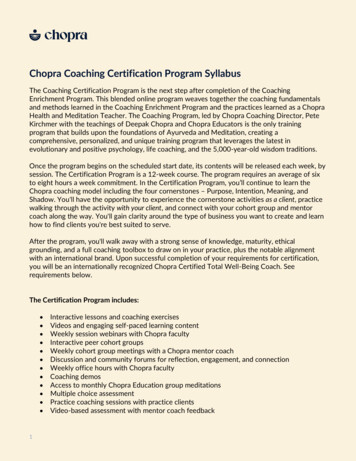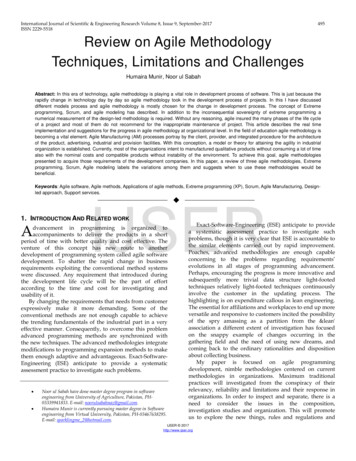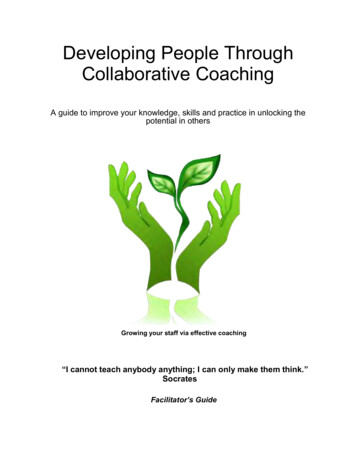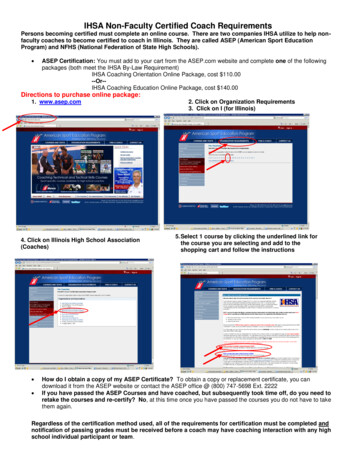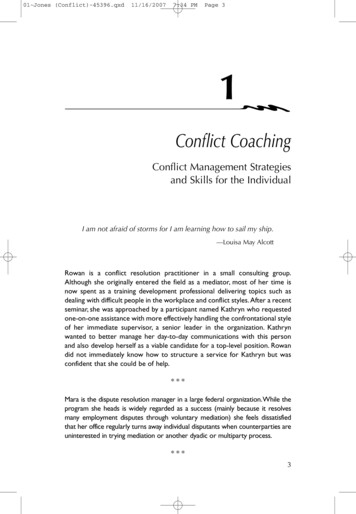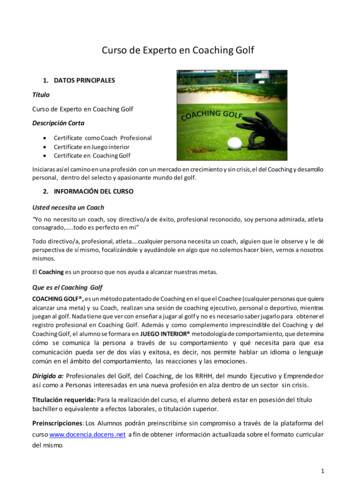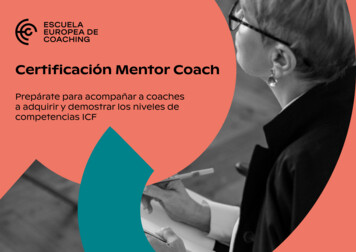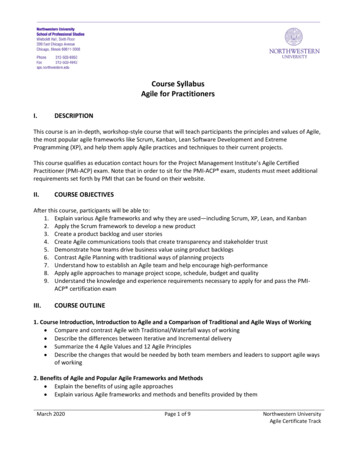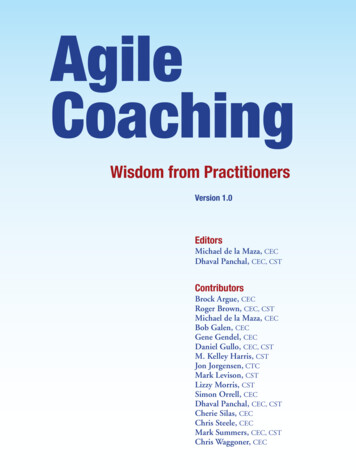
Transcription
AgileCoachingWisdom from PractitionersVersion 1.0EditorsMichael de la Maza, CECDhaval Panchal, CEC, CSTContributorsBrock Argue, CECRoger Brown, CEC, CSTMichael de la Maza, CECBob Galen, CECGene Gendel, CECDaniel Gullo, CEC, CSTM. Kelley Harris, CSTJon Jorgensen, CTCMark Levison, CSTLizzy Morris, CSTSimon Orrell, CECDhaval Panchal, CEC, CSTCherie Silas, CECChris Steele, CECMark Summers, CEC, CSTChris Waggoner, CEC
Agile CoachingWisdom from PractitionersVersion 1.0
AgileCoachingWisdom from PractitionersVersion 1.0Editors:Michael de la Maza, CEC & Dhaval Panchal, CEC, CSTContributors:Brock Argue, CECRoger Brown, CEC, CSTBob Galen, CECGene Gendel, CECDaniel Gullo, CEC, CSTM. Kelley Harris, CSTJon Jorgensen, CTCMark Levison, CSTMichael de la Maza, CECLizzy Morris, CSTSimon Orrell, CECDhaval Panchal, CEC, CSTCherie Silas, CECChris Steele, CECMark Summers, CEC, CSTChris Waggoner, CEC
AGILE COACHING: WISDOM FROM PRACTICIONERSEdited By: Michael de la Maza, CEC & Dhaval Panchal, CEC, CSTContributors: Brock Argue, CEC; Roger Brown, CEC, CST; Michael de la Maza, CEC;Bob Galen, CEC; Gene Gendel, CEC; Daniel Gullo, CEC, CST; M. Kelley Harris, CST;Jon Jorgensen, CTC; Mark Levison, CST; Lizzy Morris, CST; Simon Orrell, CEC;Dhaval Panchal, CEC, CST; Cherie Silas, CEC; Chris Steele, CEC; Mark Summers, CEC, CST;Chris Waggoner, CECCopyright 2017 by Michael de la MazaAll rights reserved.Printed in the United States of America.The text of this book is set in Adobe Garamond & Hypatia Sans ProBook layout and cover design by THDesign, Inc.First Edition: August 2017IV
Table of ContentsContributorsBrock Argue, CECBiography. Page 7The Coaching Mindset.Pages 8–9Roger Brown, CEC, CSTBiography. Page 10An Example of a 5-Minute Coaching Session with Roger Brown.Pages 11–12The Agile Coaching Mindset: An Interview with Roger Brown.Pages 13–14Michael de la Maza, CECBiography. Page 15Coaching or Mentoring? A One Act Play. Page 16The Existential Dilemma of the Agile Coach.Pages 17How Much Money Should I Save?.Pages 18–19Stress: Management vs. Team. Page 20Target State Change vs. Evolutionary Change. Page 21SAFe. Page 22Bob Galen, CECBiography. Page 23Agile Coaching – An Awful Truth.Pages 24–26We’re Coaching the Wrong People!.Pages 27–30Is It Worth the Energy?.Pages 31–33The Agile Coaching Dilemma.Pages 34–36What the World Needs is More Prescriptive Agile Coaches.Pages 37–40Gene Gendel, CECBiography. Page 41Unspoken Agile Topics.Pages 42–61Bad Choice of Verbs Associated with “Agile” by ELF People.Pages 62–63Daniel Gullo, CEC, CSTBiography.Pages 64–655 Years Ago . . . .Pages 66–69Make Agile Great Again.Pages 70–72The Lost Art of Management.Pages 73–75M. Kelley Harris, CSTBiography.Pages 77Innovation Trends to Befriend: Empathy, Safety, Culture and Invitation.Pages 78–79Jon Jorgensen, CTCBiography. Page 8016 Questions for Setting-Up a Coaching Alliance.Pages 81–82V
Table of Contents continuedMark Levison, CSTBiography. Page 83“Because Our Competitors Are” is No Reasonto Become an Agile Organizaion.Pages 84–86Simplicity.Pages 87–88Lizzy Morris, CSTValue Adaptations Even When It’s “Ouchy”. Page 90Simon Orrell, CECBiography. Page 91Executing Large EPC/EPCM Projects UsingScrum Values and Principles.Pages 92–109Dhaval Panchal, CEC, CSTBiography. Page 110My Favorite Coaching Experience.Pages 111–113The Coaching Mindset.Pages 114–116Cherie Silas, CECBiography. Page 117The Agile Manifesto — What It Means to Me.Pages 118–119Is More Really Better?.Pages 120–122Tips From the Trenches.Pages 123–125What Does Sustainable Pace Really Mean?.Pages 126–127Chris Steele, CECBiography. Page 128The Successful Coach.Pages 129–131Mark Summers, CEC, CSTBiography. Page 132How Do I Use My Agile Coach?.Pages 133–135Chris Waggoner, CECBiography. Page 136When It’s No Longer Relative.Pages 137–139VI
Brock Argue, CECBrock Argue specializes in taking an organizationalapproach to Agility, recognizing that all aspects of thebusiness benefit from the application of Agile valuesand principles. Drawing from many different disciplines, his style of facilitation creates an environment inwhich high-performing organizations can emerge. He isfocused on improving organizational Agility throughcultural change and is dedicated to growing his connections within the Agile community.Brock’s first exposure to Scrum and Agile methodsoccurred in 2006 when he and two of his peers introduced Scrum into the startup company they were working for at the time. Convinced that there must bea better way to work that released the team from repeating past mistakes, Brockhelped his team run an experiment to apply Agile principles and practices totheir work. The success of that experiment led to Scrum being rolled out acrossthe organization.As a Certified Enterprise Coach (CEC) through the Scrum Alliance , Brock’sprevious work includes agile transformations at Digital Oilfield and ADP. Basedin Calgary, AB, he is currently the Agile Coach at Benevity, Inc., a world-classsoftware social enterprise that’s helping change corporate philanthropy whileaccomplishing its social mission.In addition to his work coaching organizations, Brock provides coaching to individuals seeking to grow in their Agility as the co-founder and coach of Superheroes Academy (https://superheroes.academy).
BROCK ARGUE, CECThe Coaching MindsetOriginal Source: hing-mindsetWhat is a Coaching Mindset?As coaches, we’re told that it’s important to have a coaching mindset. Being able to demonstrate this thought pattern is often a requirement of coaching certifications and is something we look for when reviewing applications for the Scrum Alliance Certified Team Coach(CTC) and Certified Enterprise Coach (CEC) certifications. As such, this is a main focus ofour mentoring program here at Superheroes Academy. Now, the question remains, whatdoes it mean to have a coaching mindset? Let’s explore this question together.Characteristics of a Coaching MindsetWhen it comes to developing a coaching mindset we often think about what we do as coaches. This includes listening, asking powerful questions, holding space and facilitating structured conversations. While doing is important, these are techniques we use in our coachingand are not who we are as coaches. Our mindset becomes visible in what we do and how weapproach coaching situations, however, our mindset exists more in who we are as coaches.Who Are You as a Coach?Although all coaches are different and have a different style and approach to coaching, thereare some character traits and attributes that good coaches have in common. Good coachesare: Emotionally IntelligentPopularized by Daniel Goleman in his book, Emotional Intelligence: Why It Can MatterMore Than IQ, emotional intelligence (or EQ) involves growing oneself in four areas:self-awareness, self-management, social awareness and relationship management. Thisjourney starts with self-awareness as an individual becomes more able to know andunderstand their thoughts before they act. Emotionally intelligent coaches possess agreater degree of empathy towards others, including their clients. Present“Be here, prepared to be nowhere else,” says Susan Scott in her book, Fierce Conversations: Achieving Success at Work & in Life, One Conversation at a Time. CuriousMy favorite book when I was young was Curious George by H. A. Rey. Each story inthe series started with the statement that, “This is George. He was a good little monkey and always very curious.” Good coaches possess a genuine curiosity and desire forcontinuous learning.8AGILE COACHING: WISDOM FROM PRACTITIONERS
CourageousAs people, coaches are not free from fear and doubt, however we overcome this for ourclient’s sake. As Nelson Mandela put it, “. . . courage is not the absence of fear, but thetriumph over it.” NeutralMaintaining a neutral stance is a key to the coaching relationship. Our role is not tojudge, but rather to work with the client to discover new possibilities and help themreach their full potential. AccountableGood coaches hold their clients accountable for the plans and decisions they make.Coaches also maintain their own accountability for the process of coaching and upholding many of the mindsets discussed above. Action-orientedIn the recent book, The Founder’s Mentality: How to Overcome the Predictable Crises ofGrowth one of the main attributes described by Chris Zook and James Allen as critical for success is having a “bias toward action.” Coaches should have this dispositiontoo. Coaching conversations are not meandering Sunday drives in the wilderness, butrather a trip intentionally guided towards a destination, which leads to focused actionon behalf of the client. Sold on their client’s abilitiesOur belief as coaches is that our clients have all they need to succeed — they just maynot realize this yet. Coaches help their clients discover what they already know andhave a firm belief in their ability to reach their potential, even when the client waivers.As a coach, “my certainty is greater than your doubt.” – Susan Johnston (Coach Skillsfor the Agile Workplace training course, Calgary March 2016).Who are you as a coach? Which parts of the coaching mindset resonate with you the most?jjjBROCK ARGUE: THE COACHING MINDSET9
Roger Brown, CEC, CSTRoger Brown is an independent Agile Coach in SanDiego who provides training, consulting & coachingservices in Scrum and enterprise Agile adoption. He isa veteran software engineer and team lead with experience at the U.S. Veterans’ Administration, DartmouthCollege, Vicinity Corporation, Microsoft and TeleAtlas.His coaching and training clients include over 70 companies from small startups to multinational banks.Roger is a Scrum Alliance Certified Enterprise Coachand Trainer. He is a reviewer and founding member ofthe Certified Scrum Coach, Certified Enterprise Coach and Certified TeamCoach Programs at the Scrum Alliance. He has facilitated open coaching clinicsat several Agile conferences since 2009.
ROGER BROWN, CEC, CSTAn Example of a 5-minuteCoaching Session withRoger BrownBackground: Roger Brown (coach) sat down with Michael de la Maza (client) for a five minutecoaching session. Afterwards, they analyzed Roger’s approach and its impact on Michael.5-Minute Coaching SessionRoger: Tell me a little bit about your environment? Tell me about yourself at work?Michael: Excellent. The situation I’m having and it’s a situation at home, not at work.It’s my girlfriend is interested in switching jobs and she’s recently asked me forhelp in switching the job. I have like a big stake in this. I have an opinion, butI don’t really want her to switch jobs and so I’m not too sure I can support herin switching jobs.Roger: Have you said that to her straight up?Michael: No. I haven’t done that to her straight up.Roger: All right. Kind of side bar, what I’m going to do is given that story, I’m goingto reflect it back to you to see if we’re on the same page. What I hear is youhave a situation at home. I’m going to make the assumption that there’s sometension around this, at least for you, if not both of you. There’s a big decisionto be made that has impact to both of you, possibly the relationship and you’rebeing asked to help and I’m not sure if you’ve been asked, what your feelingsare about it, so maybe I’m going to ask about that. You said she asked you forhelp, I don’t know what the nature of that help would be, so my first questionis, has she asked you what you think about it in terms of how would it impactthe relationship, which is kind of the system here, right, the third party, from asystemic coaching standpoint is there’s me, there’s you, and there’s us. That’s 3parties. Has she asked you how you feel about it?Michael: She has not asked me how I feel about it and I haven’t offered my thoughts onhow I feel about it.Roger: She has asked for help in what way, help thinking through it?Michael: Yeah, help thinking through it, what’s her next step, how should she explore,how should she find out what she wants to do next, things like that.Roger: I see. It isn’t a specific job offer. It’s a change, a desire for a change?Michael: Right.Roger: Is it a big step change in terms of different career or different geography?ROGER BROWN: AN EXAMPLE OF A 5-MINUTE COACHING SESSION WITHE ROGER BROWN11
Michael: I don’t think it will be a big step in either one of those, but it might be a bigstep financially.Roger: Is that something you’ve discussed?Michael: Only a little bit and what she said, “I’m concerned about making a lot ofmoney.”Roger: That was her statement or your statement?Michael: That was her statement and that’s also my main concern.Roger: How far have you gotten into a helping activity so far?Michael: We just started. We have a meeting scheduled for Sunday morning.Roger: Are meetings a common activity in your relationship?Michael: No. This is like the first meeting that we’ve had.Roger: Sure, we’ll stop. I will tell you, I don’t know if this will make you feel better orworse, but this is my 40th year of marriage, 42nd year with my wife and whenwe have something that one of us is avoiding, we have a meeting.Michael: Okay, so it’s a practice at even very high levels of experience?Roger: Absolutely. It doesn’t even have to be avoiding because it’s unpleasant. It mightbe just because oh, I don’t want to be bothered with that right now. I’ve got otherthings I want to do.Michael: Thanks a lot.Roger: We do that, because those things are going to continue to come up, thingsthat require joint focus essentially will continue to happen in a relationship thatis sustained.Michael: Excellent.Analysis and FeedbackRoger: I didn’t really get to any coaching. I just asked a lot of questions trying to understand this circumstance.Michael: Really, it was super helpful to me. Your questions encouraged me sort of to viewwhat was going on from a higher level of abstraction, so it took me from sort ofbeing in it, to being an observer of it and looking at the dynamics of it.Roger: Fabulous.Michael: Yeah.Roger: Fabulous and maybe it’s because you’re a coach or maybe just because you’resuper smart. If I had continued, that was where I was trying to get, but youalready got there.jjj12AGILE COACHING: WISDOM FROM PRACTITIONERS
ROGER BROWN, CEC, CSTThe Agile Coaching Mindset:An Interview with Roger BrownMichael: What is the Agile coaching mindset?Roger: The Agile Coaching Mindset, hm, let me think about this. Coaching mindsetin general is a thing that one learns as one becomes a coach. The Agile variationis just, I guess, around domain knowledge of Agile practices, principles andcommon challenges.Coaching mindset has to do with serving people by helping them solve theirown problems, so that mindset is about being open to possibilities, open to thelikelihood that you, as the coach, don't know the solution to whatever problem is being addressed and not necessarily agreeing that whatever problem isexpressed by the client is the actual problem.It has to do with the ability to help the coaching client or the coachee discovermore clarity around what they're trying to achieve and some ways to achieve it.In the Agile world, I think we would add to that the idea of incrementalism —where we don't necessarily try to solve a problem in one step, but we make stepstowards a solution as we're working.Michael: If an Agile coach is in the coaching stance and the client says, “I just want youto solve the problem” what might the Agile coach say?Roger: There are a lot of things a coach can say and before a person says that, the coachis going to be ready to have that be a possibility. I'm going to just give youan example, when we do our coaches clinics at the conferences and I engagea client knowing I have a very short time to work with them, the first thingI do is ask a series of questions to determine if this person wants coaching orconsulting. Coaching is what I just described and consulting is just telling theminformation or giving a possible solution to the stated problem.The questions I ask are around the nature of what you're looking for, but alsotrying to discern if that problem or challenge, whatever it is, is clear in theclient's mind. As a coach, do you see that there might be some further layersto it? You would want to be thinking about what questions you would ask todetermine those things and if it becomes a coaching circumstance, try to peelback those layers.In the coaches clinic example, I always start with: Is this person asking aboutsomething that they might possibly be able to determine on their own or arethey simply asking for information that they don't know. That helps me decideif my job is to give them a brain dump of what I know in the domain or is itto give them true coaching to help them solve a problem that they have beenthinking about or working with for some time that they might have the solu-ROGER BROWN: THE AGILE COACHING MINDSET: AN INTERVIEW WITH ROGER BROWN13
tion to themselves — keeping in mind that I may not have the same solutionin mind.If someone says “I just want information” then I start there and watch for agreater context, I just had this happen, by the way. Someone asked me to dosome coaching with them and then someone else said that person doesn't really want coaching. She wants consulting. She is in a hurry and wants answers,because she really doesn't know enough yet to know what to ask.My approach when a person says “I just want information” is to ask a few questions around “Are you sure?”. Those questions have to do with the problem arethey trying to solve or the improvement they are trying to make. The answerswill reveal to me, from my experience, if there might be layers of inquiry ordiscovery around that topic.Michael: Is there ever any situation where you're not sure whether or not the client isable to solve the problem or is able to work through the problem and how doyou deal with that? How do you self-manage for those situations?Roger: At the limit, there is a circumstance where, as a coach, you need to have thecourage to say “I don't think I can help you”. That's the extreme, where yousay I'm not the right person for you, either because I don't know what I needto know to help you or because I don't think, from our conversations, that youcan solve this problem for some reason. There is a whole spectrum of possiblereasons. The most common one is that the client doesn’t really want to solvethe problem. This is the one that we most commonly encounter, because we'retalking about making changes in people’s behaviors and companies’ culturesand such.As a coach you may be able to detect this circumstance because you have beenthere, done that, or seen something like it. If you don't have that expertise, thenyou have to work with the client long enough to see if there is a solution. Thatcan take a while. I don't know that I answered your question though.Michael: Absolutely. When you are interviewing a coach or when you're, say, evaluatingan application for a coaching certification, how do you detect or identify thecoaching mindset in someone else?Roger: That's pretty easy. You can get it from language. Someone who's in a consultingmindset is using words like “advise”, “tell”, “suggest”, “guide them to”. Someone who is a coach uses language about asking and exploring and consideringthings that are not necessarily obvious. So the language of a coaching mindsetis more asking than telling.Back to your original question, the Agile coaching mindset, as we have cometo learn over the years, is a balance between asking and telling. There are timeswhen you can go too far one way or the other. Most “Agile Consultants” gopretty far in the telling. I've seen some cases where “Agile Coaches” go too farin the asking - where it's not satisfying to the client to continually be answeringquestions and never landing anywhere. That's how I detect the presence of acoaching mindset, from the language of the discussion or the written word inthe case of an application for certification (CTC or CEC).jjj14AGILE COACHING: WISDOM FROM PRACTITIONERS
Michael de la Maza, CECMichael de la Maza is a Scrum Alliance Certified Enterprise Coach (CEC). As an Agile consultant, his major engagements have been with Paypal, State Street,edX, Carbonite, Unum, and Symantec. Previously, hewas VP of Corporate Strategy at Softricity (acquired byMicrosoft in 2006) and co-founder of Inquira (acquiredby Oracle in 2011). He is the co-author of ProfessionalScrum with TFS (2010) and Why Agile Works: The ValuesBehind The Results (agilevalues.org). He holds a PhD inComputer Science from MIT.Michael is a Co-Active Coach and is co-organizer of the BayALN, the agile usergroup in San Francisco and the organizer of the BayALN Certified Coach SpecialInterest Group (pathtoctc.org). He loves playing, creating, and sharing gamesand co-organized the 2010 Agile Games Conference, the 2011 Agile GamesConference, and the 2016 Agile Games West Conference.He serves on the Scrum Alliance’s Certified Team Coach (CTC) review committee and the Virtual Coaching committee. He enjoys mentoring Scrum Mastersand Agile coaches who want to deepen their understanding of Agile. He alsomentors and invests in startups through Techstars Boston.He can be reached via email at michael.delamaza@gmail.com and on Twitter @hearthealthyscr.
MICHAEL DE LA MAZA, CECCoaching or Mentoring?A One Act PlayScene: Coachee and coach are in a small, carpeted study room at the company’s officeshortly after noon on Monday. Both have just returned from a disastrous, humiliating meeting with executives in which they were both belittled and criticized. The coachee is slurpingStarbucks and looking around with a harried, frenzied expression. The coach is clean shavenand is wearing jeans and glasses.(Coachee, lugubriously)“My problem is that I'm not good at anything. That's why I’m constantlyrunning into trouble. I have nothing to offer.”(Coach, helpfully and confidently)“You have something to offer everyone.”(Coachee, sarcastically and loudly)“Really? What do I have to offer Bill Gates?”(Coach, realistically)“You know more about failure than he does.”jjj16AGILE COACHING: WISDOM FROM PRACTITIONERS
MICHAEL DE LA MAZA, CECThe Existential Dilemma ofthe Agile Coach“Never promise to solve a problem. Promise 10% improvement to a working system atbest. A doubling of productivity/throughput makes you you look good, at someone else’sexpense. That person then becomes your enemy. Not worth it.”– Gerry Weinberg, Secretsof ConsultingjjjMICHAEL DE LA MAZA: THE EXISTENTIAL DILEMMA OF THE AGILE COACH17
MICHAEL DE LA MAZA, CECHow Much Money Should I Save?How much should I, an independent Agile coach save, to ensure financial stability?This question is important because Agile coaches get unexpectedly terminated far more frequently than other consultants. My friend Brian Wills likes to tell the story of the 18 monthengagement with a Fortune 50 company that was so compelling he moved his entire family2,000 miles only for the engagement to end after six months. This prompted him to createWills Rule of Agile Coaching: “No matter what you are told, assume that the engagementwill end within 6 months.”Here are some examples of my unexpected terminations: After six weeks in a three month engagement, I was asked to not return. After nine days in a multi-month engagement, I was told that theengagement was over. After one month in a multi-month engagement, I was fired while boardinga plane to the client.In none of these cases did I receive any explicit feedback prior to the termination.While quality statistics are hard to come by, all of the evidence I have is that Agile coachesfind that their engagements end prematurely far more frequently than, say, software consultants or management consultants do.That means the standard emergency fund advice — have 3 to 6 months of savings on hand— may not be sufficient to support me.How many months of savings should be in my emergency fund to ensure that I have nomore than a 1% chance of running out of money at any timein the next 10 years?Let’s start with some raw data.Here are my net earnings (in‘income points’) for the last 52months:Here are a few facts that immediately jump out at me:Between month 1 and month10 my income was -7.7 pointsso I need at least that muchmoney in my emergencysavings.18AGILE COACHING: WISDOM FROM PRACTITIONERS
My income is auto-correlated: When the going gets bad, it is really bad (months 4-10) andwhen the going is good, it is really good.A good month covers several bad months.My income is not normally distributed.Because the results are so highly auto-correlated, a simple Monte Carlo is not sufficient toprovide a good estimate of how many income units should be in my emergency fund.Here is an approximate method that will generate a time series with the same average with asimilar autocorrelation as the original time series:1. Randomly select a starting month (1-52).2. Randomly select a number of months (from 1-10) from the starting month(not that month 52 wraps around to month 1).3. Repeat steps 1 & 2 until 120 months (10 years) have been selected.For example, let’s say that the first starting month (step 1) is 17 and the randomly selectednumber of months (step 2) is 5. Then months 17-21 will be the first five months of our 240month series.Informally, it’s clear that month 4 is the worst starting month and the worst sequence ismonths 4-10. However, the likelihood of going through this exact sequence twice in a rowis extremely small. So I would expect the emergency fund to be between 7.7 (months 1-10)and 15.4 (twice months 4-10). (By sheer coincidence, both the sum of months 1-10 andmonths 4-10 is 7.7).The answer turns out to be 9.9 income points. In order to keep the chances that I will gobust to less than 1% over the next ten years, I need to have 9.9 income points in m
Agile Coaching Wisdom from Practitioners Version 1.0 Editors: Michael de la Maza, CEC & Dhaval Panchal, CEC, CST Contributors: Brock Argue, CEC Roger Brown, CEC, CST Bob Galen, CEC Gene Gendel, CEC Daniel Gullo, CEC, CST M. Kelley Harris, CST Jon Jorgensen, CTC Mark Levison, CST Michael de la Maza, CEC Lizzy Morris, CST Simon Orrell, CEC Dhaval Panchal, CEC, CST


